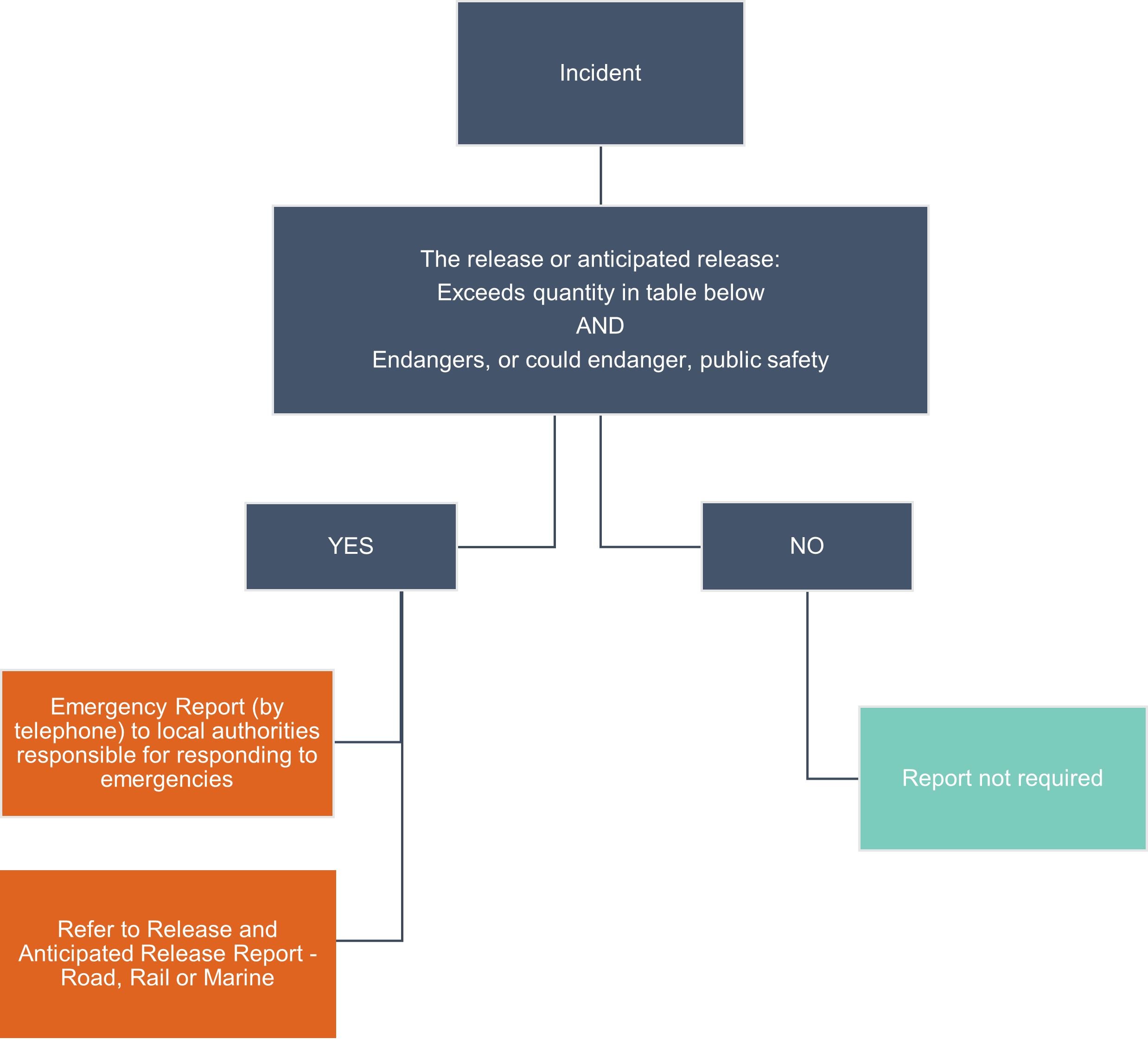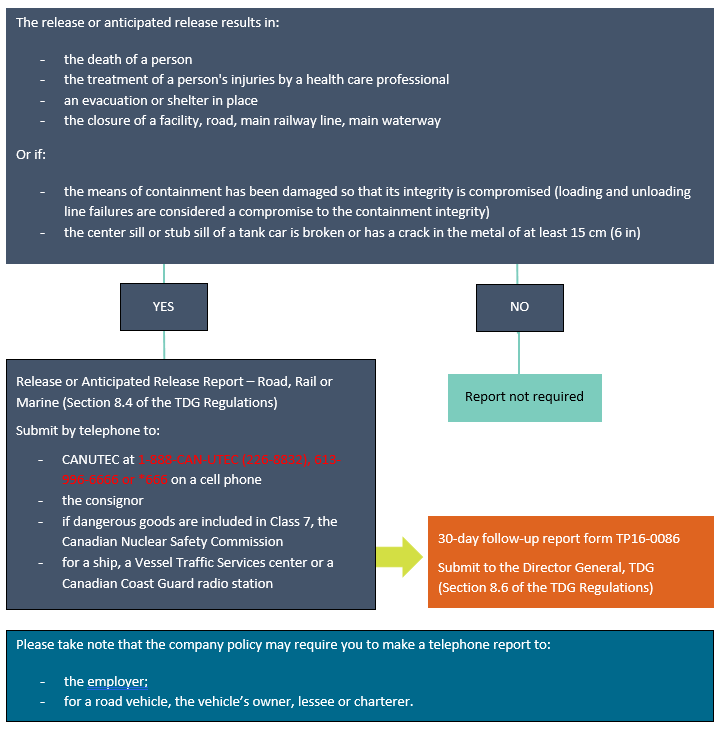Emergency report – road, rail or marine
The flowchart below should help you determine if you must make an emergency report for road, rail or marine mode (Section 8.2 of the TDG Regulations) and lists which information you need to provide (Section 8.3 of the TDG Regulations).
Description
Flowchart for Emergency Report – Road, Rail or Marine
Does the release or anticipated release exceed the quantity in the table and endanger or could it endanger public safety?
- No : Report not required
- Yes : Emergency Report by telephone must be done to local authorities responsible for responding to emergencies, Refer to Release or Anticipated Release Report - Road Rail or Marine.
Consult the list of emergency phone numbers of local authorities
| Class | Packing Group or Category | Quantity |
|---|---|---|
| 1 | II | Any quantity |
| 2 | Not applicable | Any quantity |
| 3, 4, 5, 6.1 or 8 | I or II | Any quantity |
| 3, 4, 5, 6.1 or 8 | III | 30 L or 30 kg |
| 6.2 | A or B | Any quantity |
| 7 | Not applicable | A level of ionizing radiation greater than the level established in section 39 of the Packaging and Transport of Nuclear Substances Regulations, 2015 |
| 9 | II or III, or without packing group | 30 L or 30 kg |
Information to be included in the emergency report — road, rail or marine (Section 8.3 of the TDG Regulations):
- the name and contact information of the person making the report
- in the case of a release of dangerous goods, the date, time and geographic location of the release
- in the case of an anticipated release of dangerous goods, the date, time and geographic location of the incident that led to the anticipated release
- the mode of transport used
- the shipping name or UN number of the dangerous goods
- the quantity of dangerous goods that was in the means of containment before the release or anticipated release
- in the case of a release of dangerous goods, the quantity of dangerous goods estimated to have been released
- if applicable, the type of incident leading to the release or anticipated release, including a collision, roll-over, derailment, overfill, fire, explosion or load-shift
Release or anticipated release report – road, rail or marine
The flowchart below should help you determine if you must make a release or anticipated release report for road, rail or marine mode (Section 8.4 of the TDG Regulations).
Note: This report is only required if an emergency report was made and it meets the requirements of Section 8.4.
Description
Flowchart for Release or Anticipated Release Report - Road, Rail or Marine
Did the release or anticipated release resulted in: the death of a person; the treatment of a person's injuries by a health care professional; an evacuation or shelter in place; the closure of a facility, road, main railway line, main waterway
Or if: the means of containment has been damaged so that its integrity is compromised (loading and unloading line failures are considered a compromise to the containment integrity); the centre sill or stub sill of a tank car is broken or has a crack in the metal of at least 15 cm (6 in)?
- No : Report not required
- Yes : Release or Anticipated Release Report – Road, Rail or Marine (Section 8.4 of the TDGR) must be submitted to : CANUTEC at 1-888-CAN-UTEC (226-8832), 613-996-6666 or *666 on a cell phone; and the consignor. Are the dangerous goods included in Class 7?
- No: Are you considered marine transport?
- No : Are you considered Road transport?
- No : refer to the 30-Day Follow-Up Report (Form TP16-0086)
- Yes : Please take note that the company policy may require you to make a telephone report to: the employer; or for a road vehicle, the vehicle's owner, lessee or charterer. Refer to the 30-Day Follow-Up Report (Form TP16-0086).
- Yes : A report must be made to a Vessel Traffic Services Centre or a Canadian Coast Guard radio station. Refer to the 30-Day Follow-Up Report (Form TP16-0086).
- No : Are you considered Road transport?
- Yes : A report must be made to the Canadian Nuclear Safety Commission. Refer to the 30-Day Follow-Up Report (Form TP16-0086).
- No: Are you considered marine transport?
Please take note that the company policy may require you to make a telephone report to:
- the employer;
- for a road vehicle, the vehicle’s owner, lessee or charterer.
Information to be included in the release or anticipated release report — road, rail or marine (Section 8.5 of the TDG Regulations):
- the name and contact information of the person making the report
- in the case of a release of dangerous goods, the date, time and geographic location of the release
- in the case of an anticipated release of dangerous goods, the date, time and geographic location of the incident that led to the anticipated release
- the mode of transport used
- the shipping name or UN number of the dangerous goods
- the quantity of dangerous goods that was in the means of containment before the release or anticipated release
- in the case of a release of dangerous goods, the quantity of dangerous goods estimated to have been released
- if applicable, the type of incident leading to the release or anticipated release, including a collision, rollover, derailment, overfill, fire, explosion or load-shift
- if applicable, the name and geographic location of any road, main railway line or main waterway that was closed
- a description of the means of containment containing the dangerous goods
- if applicable, an estimate of the number of people evacuated or sheltered in place
- if applicable, the number of deaths and the number of persons who sustained injuries that required immediate medical treatment by a health care provider

